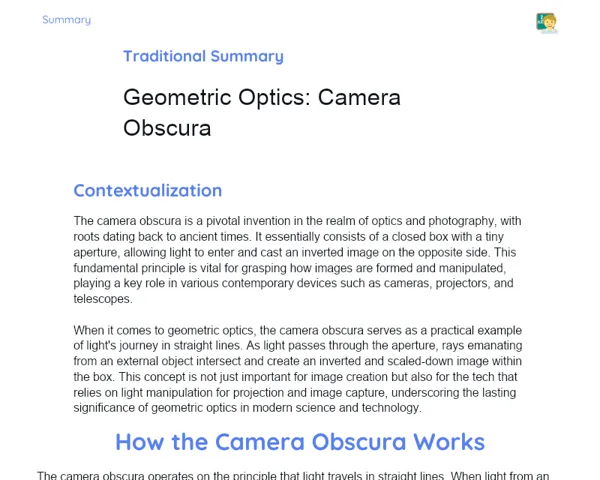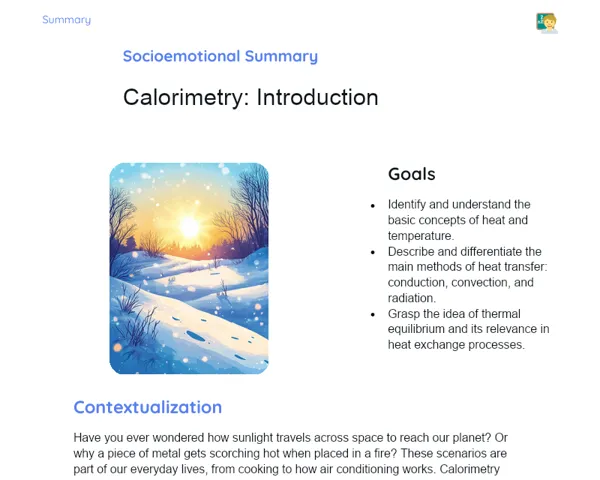Goals
1. Grasp the concept of the critical angle in geometric optics.
2. Calculate the critical angle of incidence when light transitions from a medium with a higher refractive index to one with a lower refractive index.
3. Tackle practical problems related to the determination of the critical angle, like when a light beam exits water.
Contextualization
Geometric optics is a field of physics that looks at how light travels through transparent materials and the rules that dictate the behaviour of light rays. The critical angle is key to understanding phenomena such as total internal reflection, which has a wide range of practical applications. For instance, fibre optics, vital in modern telecommunication, depends on total internal reflection to transmit data swiftly with minimal signal loss. This understanding is crucial for advancing technology in telecommunications, healthcare, and engineering.
Subject Relevance
To Remember!
Critical Angle
The critical angle is the maximum angle of incidence at which light can move from a medium of a higher refractive index, like water, to one of a lower refractive index, such as air, without experiencing total internal reflection. This phenomenon is vital for comprehending how light behaves at various material boundaries.
-
Definition: The maximum angle of incidence for refraction.
-
Importance: Critical for technologies such as fibre optics.
-
Example: Light transitioning from water to air.
Laws of Refraction and Reflection
The laws of refraction and reflection explain how light acts when it moves from one medium to another. Snell's Law, for example, links the angles of incidence and refraction to the refractive indices of the involved materials. Total internal reflection happens when the angle of incidence goes beyond the critical angle, making all the light bounce back into the original medium.
-
Snell's Law: n1 * sin(θ1) = n2 * sin(θ2).
-
Total Internal Reflection: Happens when the angle of incidence is greater than the critical angle.
-
Application: Utilised in optical devices and fibre optics.
Formula for Calculating the Critical Angle
The formula for figuring out the critical angle comes from Snell's Law, where the critical angle (θc) is calculated as θc = sin⁻¹(n2/n1), with n1 being the refractive index of the initial medium and n2 the refractive index of the final medium. This formula is essential for determining when total internal reflection takes place.
-
Formula: θc = sin⁻¹(n2/n1).
-
Relevance: Identifies the threshold for total internal reflection.
-
Example: Finding the critical angle for light moving from water to air (n1 = 1.33; n2 = 1).
Practical Applications
-
Fibre Optics: Used in telecommunications to effectively transmit data.
-
Camera Lenses: Employing the principles of refraction to enhance image clarity.
-
Medical Devices: Using fibre optics in endoscopes for diagnostics.
Key Terms
-
Critical Angle: The maximum angle of incidence for refraction.
-
Total Internal Reflection: The phenomenon where all light is redirected back into the original medium.
-
Snell's Law: The equation that connects angles of incidence and refraction with the refractive indices of different media.
Questions for Reflections
-
In what ways can knowledge of the critical angle lead to new advancements in telecommunications?
-
How does total internal reflection play a role in shaping the design of medical devices?
-
What challenges do engineers encounter when applying geometric optics principles in everyday devices?
Practical Challenge: Calculating the Critical Angle
This mini-challenge seeks to solidify understanding of calculating the critical angle and its real-world applications.
Instructions
-
Form groups of 3-4 learners.
-
Each group should calculate the critical angle for light travelling from one medium with a specific refractive index to another medium with a different refractive index. Use the formula θc = sin⁻¹(n2/n1).
-
Groups are to discuss and present how this calculation might apply in a practical scenario, like designing a fibre optic or a camera lens.
-
Share your conclusions with the class, explaining the significance of the critical angle within the provided context.



